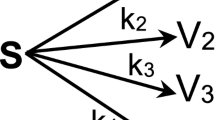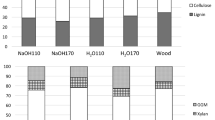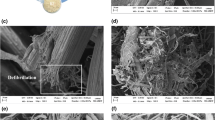Abstract
The thermal degradation behavior and the Arrhenius parameter of curaua, kenaf, and jute vegetal fibers were studied using X-ray diffraction (XRD), Fourier-transform infrared (FTIR) spectroscopy, and thermogravimetry analysis. XRD showed that the crystallite sizes in the (200) plane were in the order: curaua < jute < kenaf, and similar results were obtained for basal spacing. FTIR spectroscopy corroborated the XRD results. The thermal behavior of the fibers was analyzed by identifying the cellulose and hemicellulose content using independent parallel first-order models. The results were not very consistent with the kinetic degradation models of Kissinger, Friedman, and Flynn–Wall–Ozawa (taking into account the standard errors), which were used to determine the apparent activation energy of the fibers. In addition, the frequency factor (pre-exponential parameter) was observed to be independent of the heating rate. The fibers exhibited a compensation effect; i.e., higher apparent activation energies led to higher frequency factors. Finally, the solid-state degradation mechanism of all fibers was found to comprise diffusion and random nucleation followed by instantaneous growth of nuclei.










Similar content being viewed by others
References
Almeida Júnior JHS, Ornaghi Júnior HL, Amico SC, Amado FDR (2012) Study of hybrid intralaminate curaua/glass composites. Mater Des 42:111–117
Aquino EMF, Sarmento LPS, Oliveira W, Silva RV (2007) Moisture effect on degradation of jute/glass hybrid composites. J Reinf Plast Compos 26:219–233
Argawal UP, Reiner RS, Ralph AS (2010) Cellulose I crystallinity determination using FT-Raman spectroscopy: univariate and multivariate methods. Cellulose 17(4):721–733. doi:10.1007/s10570-010-9420-z
Badía JD, Santonja-Blasco L, Moriana R, Ribes-Greus A (2010) Thermal analysis applied to the characterization of degradation in soil of polyactide: II. On the thermal stability and thermal decomposition kinetics. Polym Degrad Stabil 95:2192–2199
Carrillo F, Colom X, Suñol JJ, Saurina J (2004) Structural FTIR analysis and thermal characterization of lyocell and viscose-type fibres. Eur Polym J 40:2229–2234
Clemons CM, Caulfield DF (2010) Natural fibers. In: Xanthos M (ed) Functional fillers for plastics, 2nd edn. Wiley, Weinheim, pp 213–222
Dai D, Fan M (2011) Investigation of the dislocation of natural fibres by Fourier-transform infrared spectroscopy. Vib Spectrosc 55:300–306
Driemeier C, Clligaris GA (2011) Theoretical and experimental developments for accurate determination of crystallinity of cellulose I materials. J Appl Crystallogr 44(1):184–192. doi:10.1107/S0021889810043955
Ebrahimi-Kahrizangi R, Abbasi MH (2008) Evaluation of reliability of Coats-Redfern method for kinetic analysis of non-isothermal TGA. Trans Nonferr Metal Soc 18:217–221
French AD (2013) Idealized powder diffraction patterns for cellulose polymorphs. Cellulose. doi:10.1007/s10570-013-0030-4
French AD, Cintrón MS (2013) Cellulose polymorphy, crystallite size, and the Segal crystallinity index. Cellulose 20:583–588
Galwey AK (1994) Magnitudes of Arrhenius parameters for decomposition reactions of solids. Thermochim Acta 242:259–264
Galwey AK (1997) Compensation behaviour recognized in literature reports of selected heterogeneous catalytic reactions: aspects of the comparative analyses and significance of published kinetic data. Thermochim Acta 294:205–219
Galwey AK (2004) Is the science of thermal analysis kinetics based on solid foundations? A literature appraisal. Thermochim Acta 413:139–183
Grønli MG, Várhegyi G, Di Blasi C (2002) Thermogravimetric analysis and devolatilization kinetics of wood. Ind Eng Chem Res 41:4201–4208
Kim U, Eom SK, Wada M (2010) Thermal decomposition of native cellulose: influence on crystallite size. Polym Degrad Stabil 95:778–781
L’vov BV (2001) The physical approach to the interpretation of the kinetics and mechanisms of thermal decomposition of solids: the state of the art. Thermochim Acta 373:97–124
Órfão JJM, Antunes FJA, Figueiredo JL (1999) Pyrolysis kinetics of lignocellulosic materials—three independent reactions model. Fuel 8:349–358
Poletto M, Pistor V, Zeni M, Zattera AJ (2011) Crystalline properties and decomposition kinetics of cellulose fibers in wood pulp obtained by two pulping processes. Polym Degrad Stabil 96:679–685
Poletto M, Zattera AJ, Forte MMC, Santana RMC (2012) Thermal decomposition of wood: influence of wood components and cellulose crystallite size. Bioresource Technol 109:148–153
Romanzini D, Ornaghi HL Jr, Amico SC, Zattera AJ (2012) Preparation and characterization of ramie-glass fiber reinforced polymer matrix hybrid composites. Mater Res 15:415–420
Sánchez-Jiménez PE, Pérez-Maqueda LA, Perejón A, Criado JM (2010) Generalized kinetic master plots for the thermal degradation of polymers following a random scission mechanism. J Phys Chem A 114:7868–7876
Satyanarayana KG, Flores-Sahagun THS, Dos Santos LP, Dos Santos J, Mazzaro I, Mikowski A (2013) Characterization of blue agave bagasse fibers of Mexico. Compos A 45:153–161
Schwanninger M, Rodrigues JC, Pereira H, Hinterstoisser B (2004) Effects of short-time vibratory ball milling on the shape of FT-IR spectra of wood and cellulose. Vib Spectrosc 36:23–40
Spinacé MAS, Lambert CS, Fermoselli KKG, De Paoli MA (2009) Characterization of lignocellulosic curaua fibres. Carbohydr Polym 77:47–53
Teng H, Wei YC (1998) Thermogravimetric studies on the kinetics of rice hull pyrolysis and the influence of water treatment. Ind Eng Chem Res 37:3806–3811
Teng H, Lin HC, Ho JA (1997) Thermogravimetric analysis on global mass loss kinetics of rice hull pyrolysis. Ind Eng Chem Res 36:3974–3977
Yao F, Wu Q, Lei Y, Guo W, Xu Y (2008) Thermal decomposition kinetics of natural fibers: activation energy with dynamic thermogravimetric analysis. Polym Degrad Stab 93:90–98
Acknowledgements
The authors would like to thank CNPq, CAPES, and FAPERGS. In addition, the authors would like to thank São Carlos Technology for donating the kenaf and jute fibers.
Author information
Authors and Affiliations
Corresponding author
Rights and permissions
About this article
Cite this article
Ornaghi Júnior, H.L., Zattera, A.J. & Amico, S.C. Thermal behavior and the compensation effect of vegetal fibers. Cellulose 21, 189–201 (2014). https://doi.org/10.1007/s10570-013-0126-x
Received:
Accepted:
Published:
Issue Date:
DOI: https://doi.org/10.1007/s10570-013-0126-x




